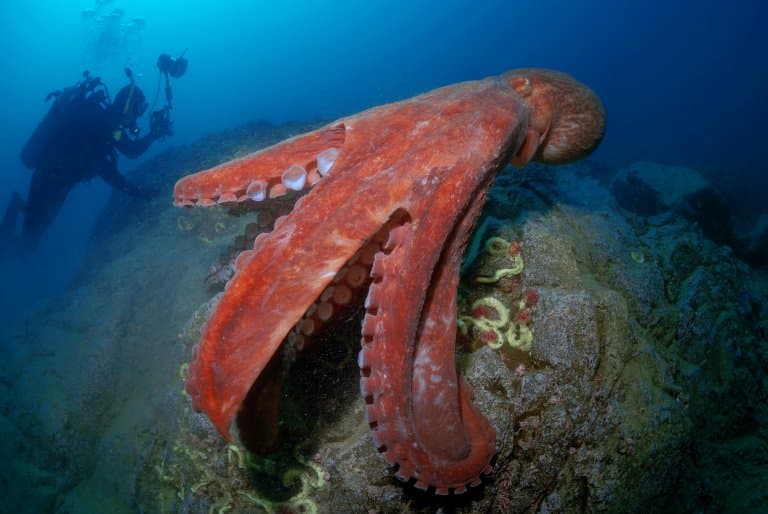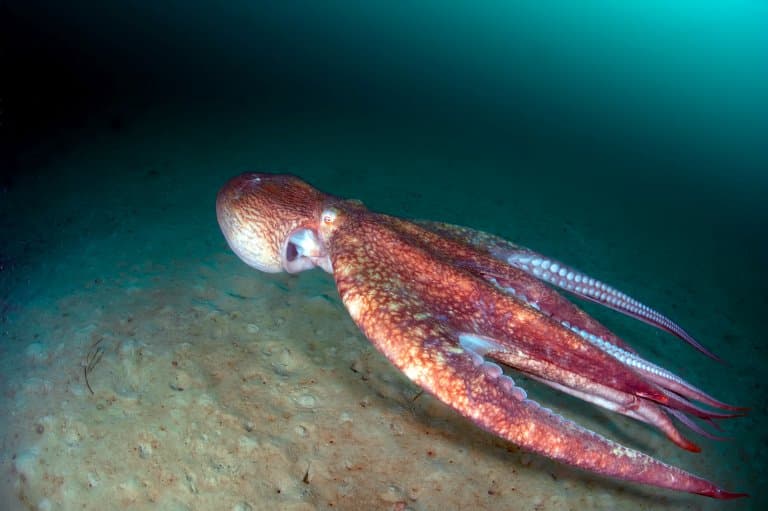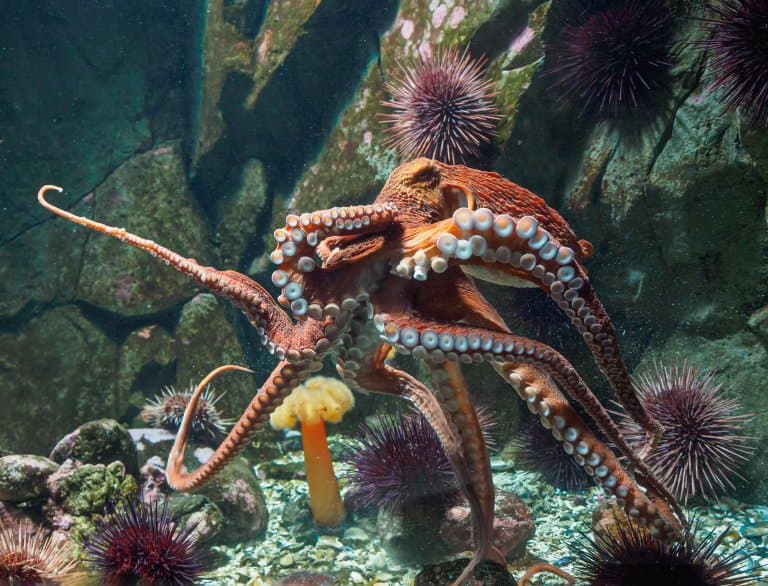Giant Pacific Octopus Profile
The giant Pacific octopus is a largest marine cephalopod species in the world, that lives in temperate waters across the Pacific Ocean.
This highly intelligent animal lives in cold oxygen-rich waters at depths of up to 2,000 m (6,600 ft), in dens within large underwater rocky outcrops.
Where no suitable dens are found, they are able to manoeuvre large boulders and rocks to create their own shelters, where they return to eat the prey they catch.

Giant Pacific Octopus Facts Overview
| Habitat: | Cold, nutrient-rich waters at depths over 100 m, as well as in shallow tidal pools |
| Location: | Throughout the Pacific Ocean |
| Lifespan: | 5 years in the wild |
| Size: | Average 4.5 m (14 ft), but some have measured over 6m (20 ft) |
| Weight: | Average 15 kg but some have weighed over 70 kg |
| Color: | Reddish but able to change colour |
| Diet: | Carnivore eating mainly crabs, clams, squid, other octopuses as well as birds and larger fish |
| Predators: | Seals, sea otters, sharks and some whales |
| Top Speed: | 40 kph (25 mph) |
| No. of Species: |
1 |
| Conservation Status: |
Least Concern |
Like other octopus species, the giant Pacific octopus has incredible eyesight, chemical and touch receptors on suckers on their arms and an ability to learn from and navigate their surroundings. Their eight arms are also able to move independently of one another, carrying out several different tasks at the same time.
Despite their large size and fairly powerful arms, the giant Pacific octopus is a relatively friendly animal and often shows great interest in people or other animals that enter into their environment. They can mimic the colour of a wet-suit or fish so as to blend into their surroundings. Some studies have even shown that they differentiate between different individuals by their movements and general behaviour. They can however deliver a nasty bite with their beak if threatened, although the venom released is not thought to be overly dangerous to humans.
The giant Pacific octopus prefers colder waters and does not adapt well to rapid changes in sea temperature. They are ectothermic animals that rely on the temperature of the surrounding water to maintain a steady body temperature. This octopus is generally solitary, only coming together with others to mate. They can stay in their dens for long periods of time, sometimes for weeks, before venturing to find food or a mate. Occasionally predators may flush giant Pacific octopuses out of their dens, but more than often they are able to use their cunning to escape.
Giant Pacific octopus use its suckers to diet shrimp, crabs, fish and other squid, before biting them using its sharp beak. It’s also believed that they prey upon small sharks, and have been witnessed catching and drowning a seagull to eat.
Although they can grow to a gigantic size, the giant Pacific octopus has a relatively short-lived life. For the first three months of its life, a giant Pacific octopus larva, measuring only 1cm, floats and swims feebly on the ocean surface. They feed on the larvae of other animals such as crabs before finally swimming down into deeper waters. Here they eat regularly and grow rapidly into a fully grown giant Pacific octopus. Most adults live to between 3 and 5 years old before they die, though some may live longer if they don’t find a mate.
The giant Pacific octopus is eaten in several countries but this does not seem to have a great effect on population numbers. They are however very sensitive to water pollution and changes in sea temperature, which can affect the larvae and adults as well as delaying or interacting in egg development. They are important in controlling crustacean, mollusc and starfish overpopulation and their larvae and juveniles provide a good source of food for many different animals.
Interesting Giant Pacific Octopus Facts
1. The giant Pacific octopus is the largest octopus in the ocean
Of all the octopus species in the ocean, the giant Pacific octopus is the largest.
The biggest specimen is said to have weighed over 272kg with a radius over 9.6m according to the Guiness Book of Records, however, these measurements are estimates, as the specimen was never collected and weighed. 1
A study in 2015 entitled “Sizing ocean giants: patterns of intraspecific size variation in marine megafauna” believe the largest specimen reliably recorded in size is 9.8 m in radius and 198.2 kg in weight, although most are usually well below 30 kg in their data set. 2

2. They are highly intelligent
Some captive individuals have learnt how to navigate mazes, open jars and even escape from their tanks.
Experts believe the size of the brain is also an important factor in determining intelligence. As far as brain-to-body ratios go, the octopus has the largest brain out of any other invertebrates (animals without spines).
For these reasons and more, octopus are in our top 10 smartest animals on the planet. 3
3. Giant Pacific octopuses have 9 ‘brains’
As well as their large brain found in their head or mantle, each arms has a “mini-brain”, capable of moving that arm independently of the others. 4
4. They can release a cloud of ink in defence
When escaping larger predators, the giant Pacific octopus will propel itself through the water and release an ink cloud to disorientate the predator.

5. They create “octopus gardens”
Tidy creatures, giant Pacific octopuses leave all the remains of their prey outside their dens in piles.
6. Giant Pacific octopi are not a crabbers friends
They have been known to use their arms to pull out the entire contents of a crab pot or net!
7. Their suckers can grow up to 6.4 cm (2.5 in) and support 15 kg each
The sensory receptors on their arms help detect prey and even allows this species to manipulate objects to use as tools.
They will sometimes collect rocks and other hard objects such as shells to create shields or doors to their dens, as well as changing den openings to where stray prey often pass.

8. Each of their 8 arms have huge amounts of suckers on the underside
A giant Pacific octopus has over 2,000 suckers on its arms.
9. They have the ability to change colour
The giant Pacific octopus has skin cells that contain different pigments that allow it to change colour in less than a second.
They can blend in with even the most intricately patterned corals, plants, and rocks from predators.5
10. Females are fantastic mothers
Although they die before or shortly after their eggs hatch, females regularly guard, clean and aerate their eggs to ensure that they hatch.
11. Both male and females do not live long after breeding
Giant Pacific octopus reproduction, as with most octopi, is truly fascinating and tragic in equal measure. These octopi can breed anytime during the year but the breeding season itself usually on lasts a few days at most. Males may mate with several females during this period but females will only mate once in their lifetime.
In her den, the female may lay up to 100,000 eggs, which hang from the ceiling of the den in clusters. The females will clean the eggs with her suckers and guard them from predators for up to a year.
After mating, male giant Pacific octopi may try to mate with other females in the vicinity that have yet to mate. One to three months after mating, males begin to move and eat less. Once they enter this period, known as senescence, they usually die within a few weeks.
Females stay in their dens, guarding their eggs and do not leave, even to eat. Sometimes females will die during this period. Even females that survive until the eggs have hatched, will die shortly after.

12. Giant Pacific octopus larvae are tiny
These tiny octopi are less than 1cm when born and are easy prey to many animals.
13. They are short-lived
Their life-span is typically 4-5 years, which seems seems very short. However, relatively to other octopus species this is long-lived – many will only live a year!
14. Little is known about their true conservation status
Giant Pacific octopus are not currently under any protection, and they have not been assessed for the IUCN Redlist.
Their population size is unknown, and they are not currently listed as endangered or vulnerable animals. They are, however, sensitive to environmental conditions and may be affected by high pollution levels in their range.
Giant Pacific Octopus Fact-File Summary
Scientific Classification
| Kingdom: | Animalia |
| Phylum: | Mollusca |
| Class: | Cephalopoda |
| Order: | Octopoda |
| Family: | Enteroctopodidae |
| Genus: | Enteroctopus |
| Species Name: |
Enteroctopus Dofleini |
Fact Sources & References
- “Largest octopus“, Guiness World Records.
- McClain CR, Balk MA, Benfield MC, Branch TA, Chen C, Cosgrove J, Dove AD, Gaskins L, Helm RR, Hochberg FG, Lee FB, Marshall A, McMurray SE, Schanche C, Stone SN, Thaler AD (2015), “Sizing ocean giants: patterns of intraspecific size variation in marine megafauna“, National Library of Medicine.
- “Giant Pacific Octopus“, Ocean Conservancy.
- “Enteroctopus dofleini“, Integrated Taxonomic Information System.
- “Giant Pacific Octopus“, National Geographic.
